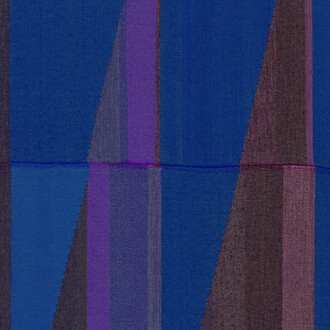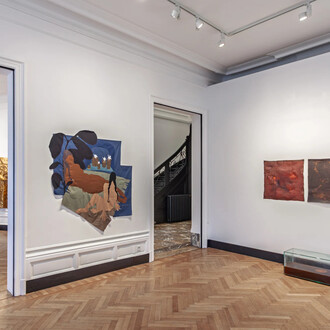Almine Rech gallery is pleased to present Markus Lüpertz's first exhibition with the gallery.
Markus Lüpertz was born in Liberec, Bohemia (former Czechoslovakia), in 1941. When Markus was still very young, the Lüpertz family moved to Germany for economic reasons. At the age of twenty, he settled in Berlin and established himself as an independent professional artist. Lüpertz is considered one of the main exponents of the brilliant postwar generation of German painters, which includes artists such as, among others, Anselm Kiefer, A.R. Penck, Georg Baselitz, Jörg Immendorff, Gerhard Richter and Sigmar Polke.
Lüpertz is perhaps the most pronounced 'painter amongst painters'. Indeed, the artist does not attempt to imagine the one or other alternate reality, but creates, first and foremost, a new pictorial space. In this, he utilizes all possible techniques, textures, formats and frames. He is constantly exploring the universal dimensions of painting. His search is based on the history of the painterly medium itself. Yet his work is also thematically based on a range of universal human values such as freedom, equality, courage, passion, love, beauty, culture and the like.
In the early 1960s, Lüpertz created a series of works entitled Dithyramben, literally “exuberant hymns”, which set the tone for his entire oeuvre. In these works, Lüpertz undertook, on the one hand, to transform graphic shapes such as letters, words, planes and lines into three-dimensional images, and on the other hand, convert real images like trees, snails, helmets and ears of wheat into purely two-dimensional painterly realities. This, however, is not disconnected from a certain artistic resistance to the then prevailing emotionally charged movements such as Informalism or figurative painting, or even the avant-garde movements of that time. Markus Lüpertz is not a painter of big emotions, but rather a painter of concepts. He refuses to recognize the unambiguous symbolic meaning of a particular image.
These works were often perceived as highly controversial. In this period, figurative painting had been declared dead because of its anti-intellectual and anti-modernist character. Lüpertz, moreover, was suspected by critics to harbor sympathies for the German nation because of his use of universal German symbols in his work. However, he used these objects primarily because of their abstract meaning and painterly value. In these paintings, he explored the universal value of symbols, rather than utilizing them because of their temporary historical connotations.
Markus Lüpertz is probably the most eclectic artist of his time. He adopts a wide variety of styles and themes that contribute to the creation of his own universe and his search for the meaning of painting. Throughout this search, he constantly hovers between objectivity, subjectivity, figuration and abstraction.
His use of styles and themes represents a fundamental freedom; it makes it possible for his art to thematize art as such, rather than its constitutive aspects, such as narration, figuration, social relevance and so on.
Every image, every sign, every gesture is like an isolated word in an unfinished poem or a sentence in a story yet to be told. Their meaning does not 'exist', but rather 'becomes' through the interplay with other images. The work of Markus Lüpertz, in this respect, is rather in line with that of the artists of early Pop art, such as Jasper Johns, who reduced the American flag to a painted landscape, deprived of all symbolic value.
From the 1980s onward, Lüpertz realized a series of works in which he addressed a number of highly important universal themes. Inspiration for these works is found in classical artists such as Poussin, Millet, Rubens and others, as well as classic art historical themes such as Parsifal and The Three Graces. In this way he conducted a journey through almost the entire history of art. All these themes are basically used in a similar manner. Lüpertz is not interested in a contemporary variation on the theme itself, but rather in the universal and timeless meaning of the theme and its pictorial expression. Precisely here lies the intrinsic value and uniqueness of Markus Lüpertz as an artist. He is not merely a brilliant producer of images but also an intense and restless seeker of universal humanistic values. As a defender of humanity, he has for many years led the Academy of Düsseldorf, undeniably one of the most important art institutions in Europe.
In 2005 the museum Dhondt-Dhaenens had the honor and pleasure to present an exhibition by the artist. The exhibition was the first individual presentation of Lüpertz in Belgium and showed a series of drawings, etchings and watercolors which were all conceived around the theme of The Three Graces, one of the most interpreted themes in art history.
Also on view was a selection from his series of 'nude backs'. Lüpertz made a hundred or so of these paintings. Working serially and a cinematic approach to visual conceptualization are characteristic of the artist. The works are more than concepts; they emerge as it were out of nowhere. One work gives rise to another in one continuous movement. A veritable flow of painterly ingenuity. The works do not thematize the sensuality of the nude. It is even difficult to discern whether they depict male or female nudes. He does, however, conduct a study of the back—a motif that has, since Rubens, been regularly explored‑and the way in which it can be given painterly significance today. The back is seen as an abstract landscape. This 'remoteness' toward sensuality does by no means imply that Lüpertz is disconnected from his subjects. He always tries to find a balance between involvement and distance. Excessive emotional attachment becomes, according to Lüpertz, too narrative; as such, it distorts images with excessive 'side effects' which cause them to lose their universality.
Markus Lüpertz is not only a gifted painter, he is also a phenomenal sculptor. In his large and small painted bronzes he rewrites the history of art and forces painting, sculpture and architecture into an intense dialog.
















